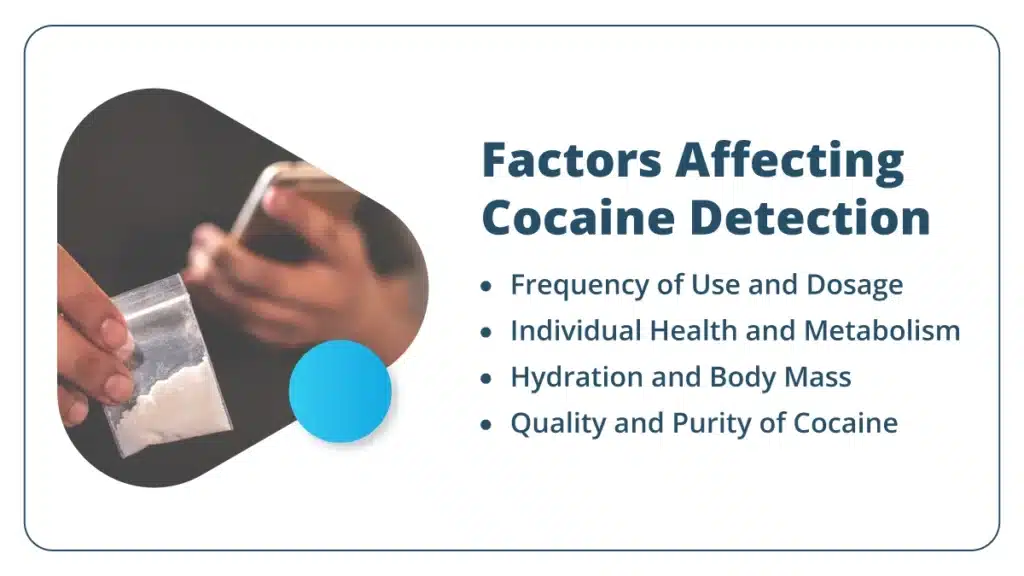Cocaine, a potent stimulant drug, can be detected through various types of drug tests, such as urine tests. The duration of cocaine in the system depends on various factors, including the individual’s metabolism and frequency of cocaine use.
Cocaine’s half-life, the time it takes for half the drug to leave the body, influences how long it remains detectable. Regular cocaine use may lead to addiction. That emphasizes the importance of understanding the drug’s persistence in your body and how it affects you.
Key Takeaways
Cocaine’s stay in the body is influenced by various factors, impacting detection across different tests. Here’s what you need to know:
- Detection windows for cocaine tests range from hours in blood to weeks in urine.
- Long-term use poses risks to physical and mental health.
- Recovery involves structured medical programs, including detox and aftercare.
The Haven Detox-South Florida is here to help you during recovery. Call us today at (561) 328-8627.
Cocaine Metabolism
Cocaine, a powerful stimulant, undergoes metabolic processes in the liver, with its half-life influencing the duration it stays in a person’s system. Upon entering the body, cocaine rapidly reaches the brain, eliciting its stimulating effects.
Cocaine’s short-lived high is attributed to its brief half-life. Subsequently, the body processes cocaine through the liver, breaking it down into metabolites. These byproducts, along with unchanged cocaine, are eventually excreted in urine. Understanding this metabolic pathway is crucial for detecting the drug in urine tests. Factors like frequency of use and individual metabolism influence how long traces of cocaine linger in the system.
Factors Affecting Cocaine Detection

Cocaine, a highly addictive stimulant drug often used in powder form, can linger in the body, influencing the duration of its effects and detection in drug tests. Understanding the interplay of various factors sheds light on the general timeline of its presence.
Frequency of Use and Dosage
Long-term cocaine use significantly impacts how long the drug stays in your system. Regular use, especially in larger amounts, extends the duration of its effects and increases the likelihood of detection in drug tests.
Individual Health and Metabolism
The body’s metabolism varies among individuals, affecting the speed at which cocaine is processed. Factors such as overall health, liver function, and metabolic rate contribute to the variation in how quickly the drug is metabolized and eliminated.
Hydration and Body Mass
Proper hydration plays a role in expediting the elimination of cocaine from the body. Additionally, body mass influences the distribution of the drug; individuals with higher body fat may retain cocaine for a more extended period.
Quality and Purity of Cocaine
The quality and purity of cocaine also play a crucial role. Impure substances or those cut with other agents can introduce additional elements that affect metabolism and elimination, potentially altering the duration of the drug’s presence.
Types of Drug Tests and Detection Windows
Cocaine detection varies across different bodily fluids and tissues, each providing insights into the presence of this stimulant drug. Understanding the detection methods and their respective windows can offer valuable information for individuals and professionals.
Detection in Blood
Cocaine is typically detectable in blood shortly after use. The detection window for blood tests is relatively short, usually within a few hours to a day. Factors such as the dose, individual metabolism, and frequency of use can influence the length of time cocaine remains detectable.
Detection in Saliva
Saliva tests offer a more immediate detection method, reflecting recent cocaine use. The presence of cocaine in saliva can be observed within minutes after use and may last for a day or slightly longer. This method is useful for detecting recent coke consumption.
Detection in Urine
Urine tests are among the most common types of drug tests used to detect cocaine. The detection window in urine is longer compared to blood and saliva, ranging from a few days to several weeks, depending on factors like the amount of cocaine used.
Detection in Hair
Hair drug tests provide a historical perspective on cocaine use. These tests analyze hair follicles for the presence of cocaine and its metabolites.
It offers a more extended detection window, often up to 90 days or more. It’s worth noting that false positives can occur, especially if a person tests positive due to environmental exposure or handling of contaminated surfaces.
Health Risks Associated with Long-term Cocaine Use
Long-term cocaine use poses significant risks to both physical and mental health. Understanding these dangers is crucial for individuals facing cocaine addiction and those involved in substance use testing methods.
Physical Health Risks
Beyond the immediate euphoria induced by this highly addictive stimulant, persistent consumption can lead to severe consequences. Here’s what you need to know about it’s health risks:
- Cocaine’s impact on the cardiovascular system can lead to high blood pressure and an increased risk of heart attack.
- Liver damage is a potential consequence, affecting the body’s ability to metabolize substances efficiently.
- The drug’s short half-life contributes to a cycle of repeated use, straining the body over time.
These physical health risks highlight the importance of considering a variety of factors when assessing the impact of cocaine on an individual’s well-being.
Mental Health Risks
Long-term cocaine use presents a complex spectrum of health risks, affecting the mental well-being of individuals. The following are its effects on your health:
- Cocaine use is linked to mental health issues, including anxiety, paranoia, and mood disturbances.
- Long-term use may contribute to cognitive impairments, affecting memory and decision-making.
- Cocaine addiction exacerbates mental health challenges, leading to a cycle of increased substance use.
Understanding the mental health risks associated with long-term cocaine use emphasizes the need for comprehensive care that addresses both the physical and psychological aspects of addiction.
Path to Recovery
Embarking on the journey to recovery from cocaine addiction often involves a carefully structured path within medical programs. From initial detoxification to ongoing aftercare, these programs aim to support individuals through each stage of recovery.
Detox
Cocaine detox is the first critical step in breaking free from cocaine misuse. In clinical settings, individuals undergo a supervised process to eliminate cocaine and its metabolites from their system. This phase addresses withdrawal symptoms, providing a supportive environment to navigate through the challenges of ending drug use within a relatively short period.
Aftercare Programs
Following detox, engaging in aftercare programs is pivotal for sustained recovery. These programs offer ongoing support, addressing the psychological and behavioral aspects of cocaine addiction.
Through professional treatment, individuals receive guidance on preventing relapse. Moreover, they learn to manage cravings and rebuild their lives beyond the temporary high that cocaine provides.
Frequently Asked Questions (FAQ)
What factors can influence how long cocaine stays in your system?
Several factors influence how long cocaine remains in your system, including individual metabolism, frequency of use, and the amount consumed. The presence of cocaine metabolites, the byproducts of its breakdown, can extend detection times.
Chronic drug addiction may prolong the substance’s stay in the body. Additionally, adverse effects, like liver damage, can affect metabolism. Cocaine’s shorter half-life leads to quicker elimination, especially when consumed in small amounts.
Are there any ways to effectively speed up the elimination of cocaine from your body?
While the half-life of cocaine limits rapid elimination, certain measures may help expedite the process. Staying well-hydrated supports kidney function, aiding in the removal of cocaine and its metabolites through urine.
Physical activity and a healthy diet may contribute to a faster metabolism, potentially hastening drug clearance. However, caution is crucial, as excessive measures can pose health risks. Binge use raises the potential for prolonged detection times, emphasizing the importance of responsible substance use.
How long does cocaine stay in your system?
The duration cocaine stays in your system depends on factors like frequency of use, metabolism, and the amount consumed. In urine, cocaine is typically detectable for a few days to several weeks.
Hair testing offers an extended window, potentially detecting use over 90 days. Factors such as drug testing methods, the presence of a cocaine use disorder, and chronic drug abuse can influence the amount of time cocaine remains detectable in the body.
Rise Above Addiction at The Haven Detox-South Florida
If you or someone you know is facing challenges related to cocaine use, seeking professional guidance is crucial. Consider reaching out to The Haven Detox-South Florida for cocaine treatment.
We prioritize your comfort and offer medical detox under medical professional care. To help you overcome withdrawal symptoms, we provide IV therapy to rehydrate your body with vital nutrients.
Let us become part of your recovery journey. Call us today at (561) 328-8627.

